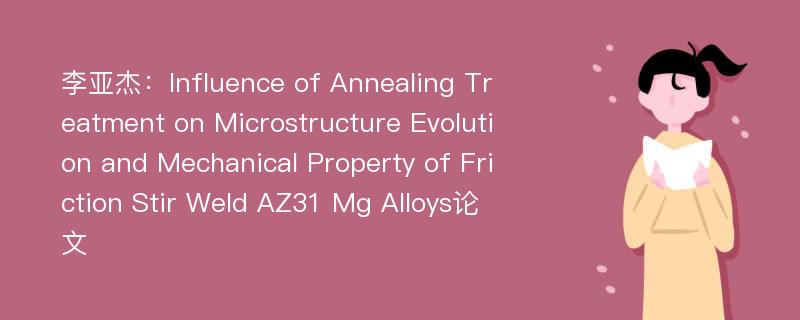
本文主要研究内容
作者李亚杰,吴志生(2019)在《Influence of Annealing Treatment on Microstructure Evolution and Mechanical Property of Friction Stir Weld AZ31 Mg Alloys》一文中研究指出:In order to improve microstructure distribution and mechanical properties of Mg alloy joint by annealing treatment, die-casting AZ31 Mg alloy was successfully welded at rotation speed of 1 400 rpm and travel speed of 200 mm/min. The welded joints were annealed at 150-300 ℃ for 15-120 min and then were subjected to transverse tensile. The microstructure of annealed joints was analyzed by optical microscopy and electron backscatter diffraction. The experimental results indicate that(0001) texture intensity in stir zone significantly reduces and sharp transition of grain size is relieved in the interface between stir zone and thermo-mechanically affected zone after annealed at 200 ℃ for 30 min. Meanwhile, the elongation is increased from 7.5% to 13.0% and strength is increased slightly. It is because that annealing treatment can inhibit twin transformation and retain its ability to coordinate deformation during tensile deformation, which contributes to the improvement of plasticity. In addition, annealing treatment can increase the width of interfacial transition zone and lead to gradual transition of grain size between the SZ and TMAZ, which balances dislocation diffusion rate in different zone.
Abstract
In order to improve microstructure distribution and mechanical properties of Mg alloy joint by annealing treatment, die-casting AZ31 Mg alloy was successfully welded at rotation speed of 1 400 rpm and travel speed of 200 mm/min. The welded joints were annealed at 150-300 ℃ for 15-120 min and then were subjected to transverse tensile. The microstructure of annealed joints was analyzed by optical microscopy and electron backscatter diffraction. The experimental results indicate that(0001) texture intensity in stir zone significantly reduces and sharp transition of grain size is relieved in the interface between stir zone and thermo-mechanically affected zone after annealed at 200 ℃ for 30 min. Meanwhile, the elongation is increased from 7.5% to 13.0% and strength is increased slightly. It is because that annealing treatment can inhibit twin transformation and retain its ability to coordinate deformation during tensile deformation, which contributes to the improvement of plasticity. In addition, annealing treatment can increase the width of interfacial transition zone and lead to gradual transition of grain size between the SZ and TMAZ, which balances dislocation diffusion rate in different zone.
论文参考文献
论文详细介绍
论文作者分别是来自Journal of Wuhan University of Technology(Materials Science)的李亚杰,吴志生,发表于刊物Journal of Wuhan University of Technology(Materials Science)2019年02期论文,是一篇关于,Journal of Wuhan University of Technology(Materials Science)2019年02期论文的文章。本文可供学术参考使用,各位学者可以免费参考阅读下载,文章观点不代表本站观点,资料来自Journal of Wuhan University of Technology(Materials Science)2019年02期论文网站,若本站收录的文献无意侵犯了您的著作版权,请联系我们删除。
标签:Journal of Wuhan University of Technology(Materials Science)2019年02期论文;
